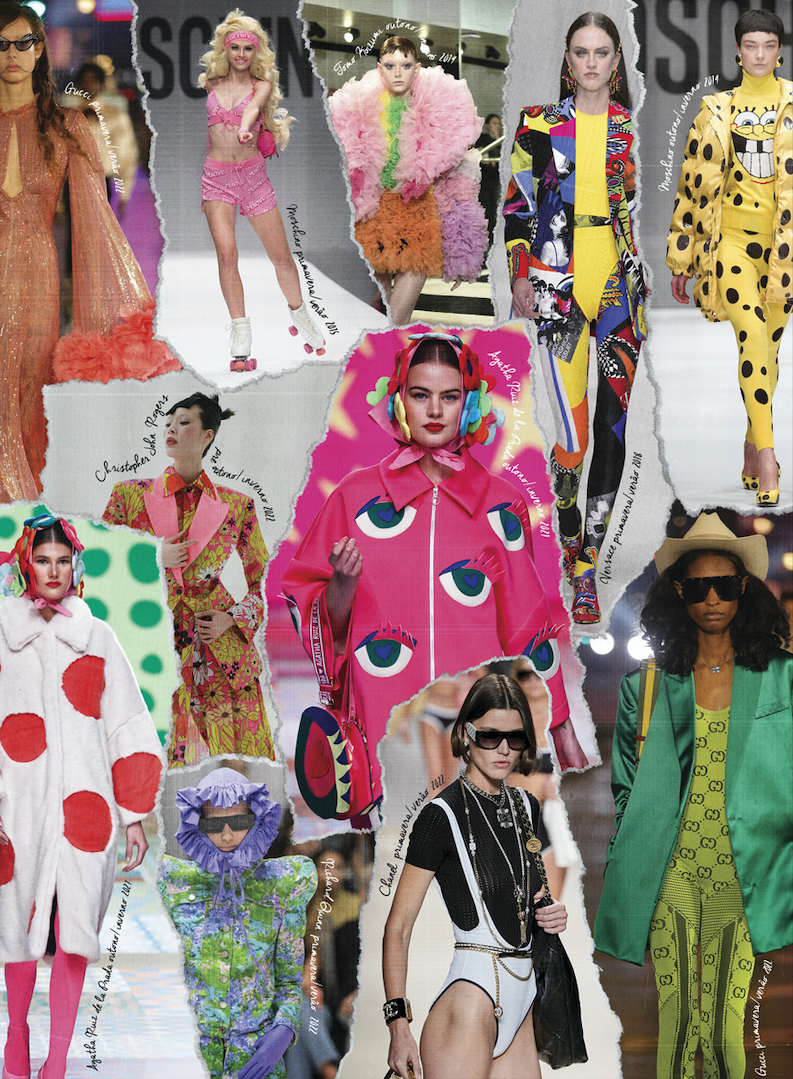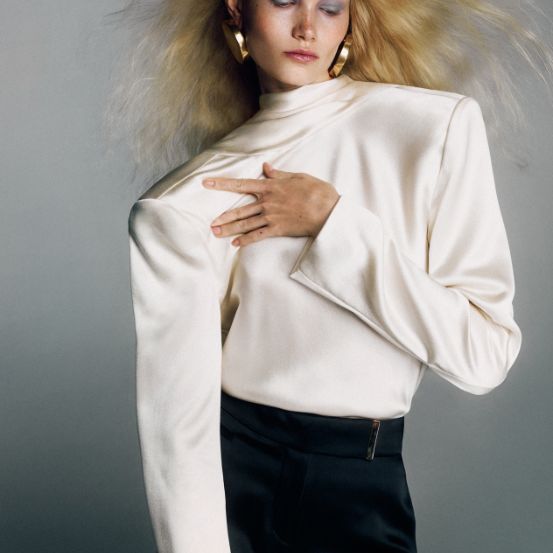Joy, the one trend we never want to end. In life and in fashion.
Joy, the one trend we never want to end. In life and in fashion.

© Imax Tree
© Imax Tree
No one was expecting it. The last time we had seen Mrs. Beckham smiling was in 2007, in a photograph taken backstage for The Return of The Spice Girls world tour, which marked the first time the group had reunited on stage since Geri Halliwell's departure in 1998. Still, that image was light years away from the happiness that the former singer radiated in 2001, at the presentation of her autobiography, Learning to Fly. So when in 2008 Victoria Beckham appeared in Marc Jacobs' spring/summer 2008 campaign, photographed by Jurgen Teller, stepping out of a giant Marc Jacobs shopping bag, the world stopped. How was it possible that the woman the public imagined as circumspect and demure could be such a character? Was Posh, after all, nice? Apparently, yes. The campaign was not only a success: it became iconic. Victoria would eventually present, in September of that year, her first collection, which caught the critics' attention and surprised everyone who had turned up their noses at the persona they knew... through glossy magazines. The name "Victoria Beckham" became synonymous with good taste and sophistication — and with the help of social media, internet users have succumbed to the charms of Mrs. Beckham, who not only smiles but also has a very keen sense of humor. In 2017 she released a t-shirt that read "Fashion stole my smile" and, a year later, to celebrate the 10th anniversary of her brand, she slipped into a shopping bag again, with Jacobs' blessing and Teller's help, for the first ad for her ready-to-wear line.
Why does all this matter? Because. The reinvention of Victoria Beckham — who went from being the tabloid's ugly duckling to the cool mum everyone loves — is proof that the happy, unpretentious side of fashion is a thousand times more interesting than its harsh side. Take the backlash that some fast fashion chains once suffered when it came to the apparent "unhappy face" of the models that starred in their campaigns. "The reason why models don't smile" was one of the most covered topics in 2016, when a paradigm shift began to take place in the approach to the mood that should guide the brands' communication. Not all of them, of course. Kayne West's Yeezy is governed by other values. In 2016, backstage at the show that served to present its third collection, the instructions given to the models were quite explicit — and were written in caps lock, just in case anyone had any doubts — and included orders such as "keep calm," "don't try to look cool," "no sexy poses," "no quick moves," "don't smile," "don't dance," "don't make eye contact with anyone." Before long, these demands went viral. Most of all because they confirmed an outdated idea that maintains that fashion has to be circumspect and boring, that it cannot laugh at itself, that it has to take itself too seriously. "Humor should be a natural part of clothing," Jean Paul Gaultier said in the 1990s, "I don't believe there is good taste or bad taste. I prefer to be fun and decadent, camp and glamorous," Marc Jacobs assumed in the early 2010s. Unfortunately, not everyone took note, and as the industry became an ultra-corporatized giant, joie de vivre gave way to an (exacerbated) preoccupation with etiquette and composure.
Fortunately there are free spirits who insist on going against the current of boredom, and on contributing to the (much needed) serotonin injection of fashion lovers. Jeremy Scott, for instance, doesn't give a damn about morals and good manners. The American, recognized as one of the most irreverent designers in the industry, took over as creative director of Moschino in 2013 and his boldness brought a breath of fresh air to the Italian company — and more than doubled its sales. His proposals, which are never by the book, reflect a perfect union of irony, satire, and an immense admiration for pop culture: Scott has reinterpreted McDonald's uniforms, made leggings and sweaters with the image of SpongeBob SquarePants, designed long dresses that were actually replicas of Hershey's chocolate bars... Not forgetting that Barbie-inspired collection for spring/summer 2015, which left Elle Woods followers (see: Legally Blonde, Reese Witherspoon, movies you really must see before you die) eternally grateful. And speaking of Barbie, she stars in the first surprise of 2022, courtesy of Balmain: the limited edition Balmain X Barbie has clothes, accessories, and even an NFT, all genderless and colorful, the worst nightmare of the narrow-minded minds. Demna Gvasalia also turned to cartoons when it came to unveiling Balenciaga's spring/summer 2022. Showing once again why he is considered a visionary, Gvasalia surprised everyone with a ten-minute video that was nothing more than a personalized episode of one of the most famous television series of all time, The Simpsons. The yellow family turned out to be the perfect vehicle for a satire on the fashion industry — when Homer comes across a Balenciaga advertisement, of which Marge seems to be a fan, he decides to send the brand an e-mail asking them to send him the cheapest piece in the showroom. And so it is: a €19.000 dress arrives at his home in Springfield. As they say these days in social media jargon, "tell me you're criticizing the exorbitant prices of luxury brands, of which you are part of, without being critical of the exorbitant prices of luxury brands, of which you are part of."
One thing is certain. There were decades when fashion was happy. The 60s, where pieces like Mary Quant's miniskirt, PVC boots, mini dresses in a thousand and one colors, and transparent raincoats coexisted, seem to have been immune to feelings of arrogance and melancholy. For sure the young people of that era would ask, confronted with the seriousness of the teenagers of the 90s, who followed minimalism as if it were a religion, "Why so serious?" What if the artists who emerged in the 80s — usually connoted as "of bad memory", but during which sequins, lurex and lamé were used and abused, following the rule "dance like no one is watching” — looked up
to see how the idols of today suffer the endorsement of a cancel culture that rushes to criticize others without giving room for creativity, you would agree that it is necessary to rescue the innocence of myths like Gianni Versace, for whom fashion has always been synonymous with joy. Today it’s names like Alessandro Michele, who has transformed Gucci into a luxury playground, never giving up humor in the dozens of campaigns the brand launches throughout each season, to attract a clientele thirsty for a more positive and optimistic discourse. Because Michele knows he's not just selling clothes or accessories. He is selling a dream. From memes to campaigns photographed by Martin Parr (the master of kitsch), the Italian has created a universe where those who feel outside the box and are not afraid of being labeled aliens can fit. Even the most faithful lover of total black ends up succumbing to this fairy tale, because the magic that Gucci emanates is seductive and irresistible. And no one is indifferent to it.
Coincidence or not, what's certain is that since Michele’s arrival, in 2015, fashion has seemed to "relax." Since 2019, the term "color block" has recurrently emerged as a trend. The world seems to be increasingly open to color and what we used to consider eccentric or maximalist is now almost mainstream. How is this change perceived by those who work, day in and day out, in the middle of a rainbow? "I find it fantastic, inspiring, and for those who work for a reference like Agatha, I feel that justice was done to her! For decades color was eschewed, it was compromising, sort of synonymous with eccentricity.... Suddenly, everyone wants to be part of team color. It remains to be seen who are the true disciples of the rainbow and who are simply cashing in on the color gravy train. On an aesthetic level, as they say in Spain, it gives me an immediate subidón to observe how the teens of 2022 give absolutely everything in terms of mixtures and stylistic blends. Bravo for Patricia Field's proposals for Lily Collins in Emily in Paris and the make-up and nail art of the various protagonists of Euphoria. This generation lives and breathes in a much freer way... And being free is a luxury." Catarina Valente is Head of Comms, PR & Collaborations at Agatha Ruiz de la Prada, so it's not an exaggeration to say she knows what she's talking about. Her "jefa", as the most famous Spanish designer is nicknamed, is a legend when it comes to color. Her career is a hymn to boldness and exuberance, her creations are the ultimate in colorful, almost acidic clothes. "Agatha was a pioneer from a business and an aesthetic point of view. She defended the indefensible, from her stratospheric shapes to the most impossible combinations ever witnessed on a catwalk.... Even so, she built an empire, reaching almost every house in Spain and elsewhere through an infinite variety of objects. She did what she liked, when she liked, always with color, concept and courage. She stood up for herself! After 40 years of love for art, she is a reference (with a big R), absolutely idolized by the new generations, who call the studio every day asking for internships and advice from the "jefa", the "fairy godmother", the woman who for almost half a century has defended the importance of being ourselves, the importance of standing up for ourselves and, above all, the importance of being free.”
Until the collision with comet Agatha, Catarina Valente thought and wore black. Then things changed. First it was the contract, written in pink and signed with a pen in the same color. Then it was the hint that dark looks are not to be applauded, not even at parties whose dress code is formal. "Over these past few years color has satisfied and nurtured the bolder, happier and uncomplicated side of my personality. I have grown and evolved on a personal and professional level surrounded by color, I have become more open and much less serious thanks to its presence in my daily life," she confesses. And she has also started mixing patterns. "It's a style challenge with gigantic trial and error process, a constant learning and, I would even say, a creative process! Fashion in general says a lot about us and each one's personal neuroses... I am in a more open phase of my life, which makes me feel less inhibited on all levels, especially on a stylistic level. I feel like risking, exploring, mixing and simplifying!” And she finishes: "Nowadays, after almost a decade of 'color-therapy', I find total black too easy, unoriginal, heavy, and 'annulling'. It brings me a sense of emptiness and defeat..." There it is, "Why so serious?".
Translated from the original on Vogue Portugal's Celebrate Yourself issue, published February 2022.Full story and credits on the print issue.
Most popular


Relacionados
.jpg)


LightHouse Publishing x Street Smash Burgers: uma noite no escritório da Vogue Portugal
19 Dec 2025
 (14).png)


